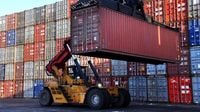Kazakhstan has been actively developing its trade relations since gaining independence, with Italy, China, and Russia currently leading as its main trading partners. Experts are now discussing the potential for Kazakh goods to reach new markets, including Pakistan. The country's strategic location in the center of Eurasia positions it as a crucial hub for international trade, appealing to both Western and Eastern partners.
This historical significance is underscored by Kazakhstan's role along the ancient Silk Road, which facilitated the exchange of goods like silk, spices, and precious metals, as well as knowledge and cultural traditions. Today, efforts are underway to establish a "New Silk Road," which includes constructing highways to connect Kazakhstan with neighboring countries, opening new border crossings, and renovating existing ones. This initiative is part of Kazakhstan's active participation in global supply chains, which not only boosts economic growth but also fortifies international relations.
Rich in natural resources, Kazakhstan is a significant player in the raw materials market. According to official statistics from 2024, the country exports crude oil, petroleum products, copper, and copper concentrates, while primarily importing consumer goods, food, household appliances, and electronics. The Ministry of Trade and Integration (MTI) has highlighted the potential for Kazakhstan to export high-value-added goods.
Kairat Torebaev, the future Vice Minister of Trade and Integration, emphasized the importance of increasing the added value of products within Kazakhstan. "New export products are primarily related to deeper processing of the goods we have in Kazakhstan. We have a strong interest in added value within Kazakhstan—this includes metals, their extraction, processing, and subsequent export," he stated. The MTI aims to achieve $41 billion in exports of processed products by the end of 2025.
Alongside this, the ministry is working to open new sales markets, with Pakistan being a focal point. "Geographically, it seems close, but there’s Afghanistan in between. Therefore, we are working closely with the Afghan government. Each year, Deputy Prime Minister Serik Zhumangarin travels there, and we invite them here. We are exploring both their market and that of Pakistan. Essentially, it’s two markets in one bottle. Everything produced in Kazakhstan, particularly in agriculture, is supplied there," the spokesperson explained.
Deputy of the Mazhilis, Aidarbek Khodzhanazarov, argues that Kazakhstan must first determine what it can sell before deciding where to sell it. "Today, we export everything we can. However, the issue is that we mainly export raw materials. We need to consider adding value and processing. We must start processing in our key sectors—subsoil use, processing of solid minerals, oil, gas, and, of course, agricultural products. I believe these three areas, given to us by nature, have not yet been fully tapped. We need to move towards deeper processing in these areas, as these products are in demand," he asserted.
Khodzhanazarov also pointed out the presence of rare earth metals that could be processed and sold abroad, which he considers a competitive advantage. He provided an example regarding uranium: "Currently, one ton of uranium sells for $50,000. However, if enriched and used for electricity, that same ton could generate a billion dollars. Thus, we can increase the value from $50,000 to a billion. But to achieve this added value, we need to invest and create infrastructure."
The government is taking significant steps to diversify the economy, including a large-scale program to support investment projects in manufacturing, small and medium-sized businesses, and large enterprises. This initiative encompasses light and chemical industries, food production, construction materials, mechanical engineering, and cargo transportation, as well as the implementation of anchor, infrastructure, and cluster projects that foster favorable conditions for small and medium-sized businesses.
For instance, the Baiterek National Managing Holding plans to allocate 8 trillion tenge for these purposes in 2025, with plans to increase funding to 10 trillion tenge by 2027. This financial backing will support various sectors, enhancing the overall economic landscape.
In a related development, Kazakhstan exports approximately 14.3 million tons of ore annually. The Ministry of Industry and Construction provided insights into the volume of raw material exports from the mining and metallurgical sectors. Deputy Azat Peruashev has raised concerns regarding companies like Kazakhmys, which allegedly export ore and concentrates without conducting chemical analyses.
In February 2025, a former laboratory specialist from Kazakhmys revealed on social media that the corporation sends tons of copper and concentrates without chemical analysis, thereby concealing valuable and rare metals. This practice, according to the specialist, allows the company to undervalue the exported resources, harming the country's economy in favor of oligarchs.
An expert in geology corroborated this claim, indicating that the mining giant has been exporting ore and concentrates without analysis for decades, supplying raw materials of rare metals to foreign industries. Peruashev noted that this issue has been brought to the attention of the relevant authorities.
Before Kazakhstan joined the Customs Union (now the Eurasian Economic Union), ore exports were unregulated. Since 2009, restrictions have been imposed on the export of raw materials containing gold. As per Article 8, Part 2 of the Law on Precious Metals and Precious Stones, those intending to export raw materials containing precious metals must obtain a refusal from all entities involved in the extraction of precious metals or confirmation from an authorized body regarding the existence of such a refusal.
The volumes of raw material exports in the mining and metallurgical complex mainly consist of concentrates. In 2024, the exported volumes included: 5.7 million tons of non-agglomerated iron concentrates (9.4% less than in 2023), 4.8 million tons of agglomerated iron concentrates (2.4% less), 1.8 million tons of copper concentrates (5.6% less), and 214.4 thousand tons of manganese concentrates (36.3% more). Other exports included lead, zinc, chromium concentrates, and bauxites, with varying changes in volume compared to the previous year.





